The Effect of Music Tempo on Fatigue Perception at Different Exercise Intensities
Abstract
1. Introduction
2. Methods
2.1. Subjects
2.2. Experimental Design
2.3. Independent Variable
2.3.1. Music Tempo
2.3.2. Exercise Intensity
2.3.3. Music Tempo with Exercise Intensity
2.4. Dependent Variable
2.4.1. Time to Fatigue Perception
2.4.2. Instantaneous HR
2.4.3. Surface Electromyography Signal
2.5. Experimental Apparatus
2.6. Experimental Procedure
2.6.1. Acquisition of Resting HR
2.6.2. Pre-Run Safety Instructions and Warmup
2.6.3. Acquisition of sEMG before Running
2.6.4. Running Experiment and Data Collection
2.7. Data Processing and Analysis
3. Results
3.1. Examination of the Effects of Music Tempo and Exercise Intensity
3.2. Time to Fatigue Perception
3.3. HR Changes
3.4. sEMG Changes
4. Discussion
4.1. The Effect of Music Tempo on Runners’ Subjective Perception of Fatigue at Different Exercise Intensities
4.2. The Effect of Music Tempo on HR Differential at Different Exercise Intensities
4.3. Effect of Music Tempo on the Difference in MF at Different Exercise Intensities
4.4. Pratical Applications
4.5. Limitations
5. Conclusions
Supplementary Materials
Author Contributions
Funding
Institutional Review Board Statement
Informed Consent Statement
Data Availability Statement
Conflicts of Interest
References
- Pageaux, B. Perception of effort in exercise science: Definition, measurement and perspectives. Eur. J. Sport Sci. 2016, 16, 885–894. [Google Scholar] [CrossRef] [PubMed]
- Taylor, J.L.; Amann, M.; Duchateau, J.; Meeusen, R.; Rice, C.L. Neural contributions to muscle fatigue: From the brain to the muscle and back again. Med. Sci. Sports Exerc. 2016, 48, 2294. [Google Scholar]
- Azevedo, R.; Silva-Cavalcante, M.D.; Gualano, B.; Lima-Silva, A.; Bertuzzi, R. Effects of caffeine ingestion on endurance performance in mentally fatigued individuals. Eur. J. Appl. Physiol. 2016, 116, 2293–2303. [Google Scholar] [CrossRef] [PubMed]
- Shin, M. Interactive effect of listening to music and mid- and post-exercise affective change on exercise intention. Psychol. Health Med. 2021, 1–7. [Google Scholar] [CrossRef]
- Gholami, M.; Napier, C.; Patiño, A.G.; Cuthbert, T.J.; Menon, C. Fatigue monitoring in running using flexible textile wearable sensors. Sensors 2020, 20, 5573. [Google Scholar] [CrossRef]
- Clansey, A.C.; Hanlon, M.; Wallace, E.S.; Lake, M.J. Effects of fatigue on running mechanics associated with tibial stress fracture risk. Med. Sci. Sports Exerc. 2012, 44, 1917–1923. [Google Scholar] [CrossRef] [PubMed]
- Swain, D.P.; Franklin, B.A. Comparison of cardioprotective benefits of vigorous versus moderate intensity aerobic exercise. Am. J. Cardiol. 2006, 97, 141–147. [Google Scholar] [CrossRef] [PubMed]
- Brown, D.M.; Bray, S.R. Effects of mental fatigue on exercise intentions and behavior. Ann. Behav. Med. 2019, 53, 405–414. [Google Scholar]
- Nikol, L.; Kuan, G.; Ong, M.; Chang, Y.-K.; Terry, P.C. The heat is on: Effects of synchronous music on psychophysical parameters and running performance in hot and humid conditions. Front. Psychol. 2018, 9, 1114. [Google Scholar]
- Meng, Q.; Jiang, J.; Liu, F.; Xu, X. Effects of the musical sound environment on communicating emotion. Int. J. Environ. Res. Public Health 2020, 17, 2499. [Google Scholar] [CrossRef]
- Yamamoto, T.; Ohkuwa, T.; Itoh, H.; Kitoh, M.; Terasawa, J.; Tsuda, T.; Kitagawa, S.; Sato, Y. Effects of pre-exercise listening to slow and fast tempo music on supramaximal cycle performance and selected metabolic variables. Arch. Physiol. Biochem. 2003, 111, 211–214. [Google Scholar] [PubMed]
- Rejeski, W.J. Perceived exertion: An active or passive process? J. Sport Exerc. Psychol. 1985, 7, 371–378. [Google Scholar]
- Faulkner, M.; McNeilly, A.; Davison, G.; Rowe, D.; Hewitt, A.; Nevill, A.; Duly, E.; Trinick, T.; Murphy, M. Music tempo: A tool for regulating walking cadence and physical activity intensity in overweight adults? Int. J. Environ. Res. Public Health 2021, 18, 7855. [Google Scholar] [PubMed]
- Crust, L. Perceived importance of components of asynchronous music during circuit training. J. Sports Sci. 2008, 26, 1547–1555. [Google Scholar] [CrossRef][Green Version]
- Stork, M.J.; Kwan, M.Y.; Gibala, M.J.; Martin Ginis, K. Music enhances performance and perceived enjoyment of sprint interval exercise. Med. Sci. Sports Exerc. 2015, 47, 1052–1060. [Google Scholar]
- Karageorghis, C.I.; Priest, D.-L. Music in the exercise domain: A review and synthesis (Part I). Int. Rev. Sport Exerc. Psychol. 2012, 5, 44–66. [Google Scholar] [CrossRef]
- Edworthy, J.; Waring, H. The effects of music tempo and loudness level on treadmill exercise. Ergonomics 2006, 49, 1597–1610. [Google Scholar] [CrossRef]
- Nethery, V.M. Competition between internal and external sources of information during exercise: Influence on RPE and the impact of the exercise load. J. Sports Med. Phys. Fit. 2002, 42, 172–178. [Google Scholar]
- Pujol, T.J.; Langenfeld, M.E. Influence of music on Wingate Anaerobic Test performance. Percept. Mot. Skills. 1999, 88, 292–296. [Google Scholar]
- Maddigan, M.E.; Sullivan, K.M.; Halperin, I.; Basset, F.A.; Behm, D.G. High tempo music prolongs high intensity exercise. PeerJ 2019, 6, e6164. [Google Scholar] [CrossRef]
- Karageorghis, C.; Jones, L.; Low, D. Relationship between exercise heart rate and music tempo preference. Res. Q. Exerc. Sport 2006, 77, 240–250. [Google Scholar] [PubMed]
- Hutchinson, J.; Sherman, T. The relationship between exercise intensity and preferred music intensity. Sport. Exerc. Perform. 2014, 3, 191. [Google Scholar]
- Cohen, J. Statistical Power Analysis for the Behavioral Sciences; Routledge: New York, NY, USA, 2013. [Google Scholar]
- Scheer, F.A.J.L.; Hu, K.; Evoniuk, H.; Kelly, E.E.; Malhotra, A.; Hilton, M.F.; Shea, S.A. Impact of the human circadian system, exercise, and their interaction on cardiovascular function. Proc. Natl. Acad. Sci. USA 2010, 107, 20541–20546. [Google Scholar] [CrossRef] [PubMed]
- Karageorghis, C.; Jones, L.; Stuart, D.P. Psychological effects of music tempi during exercise. Int. J. Sports Med. 2008, 29, 613–619. [Google Scholar] [CrossRef]
- Da Cunha, F.A.; Farinatti, P.T.V.; Midgley, A.W. Methodological and practical application issues in exercise prescription using the heart rate reserve and oxygen uptake reserve methods. J. Sci. Med. Sport 2011, 14, 46–57. [Google Scholar]
- Chai, G.; Wang, Y.; Wu, J.; Yang, H.; Tang, Z.; Zhang, L. Study on the recognition of exercise intensity and fatigue on runners based on subjective and objective information. Healthcare 2019, 7, 150. [Google Scholar] [CrossRef]
- Williams, N. The Borg rating of perceived exertion (RPE) scale. Occup. Med. 2017, 67, 404–405. [Google Scholar] [CrossRef]
- Kim, T.; Han, J.; Lee, J.; Choi, Y. The effect of polarized training on the athletic performance of male and female cross-country skiers during the general preparation period. Healthcare 2021, 9, 851. [Google Scholar] [CrossRef]
- Finni, T.; Hu, M.; Kettunen, P.; Vilavuo, T.; Cheng, S. Measurement of EMG activity with textile electrodes embedded into clothing. Physiol. Meas. 2007, 28, 1405. [Google Scholar] [CrossRef]
- Ražanskas, P.; Verikas, A.; Viberg, P.-A.; Olsson, M.C. Predicting physical parameters in fatiguing bicycling exercises using muscle activation timing. Biomed. Signal Process. Control 2017, 35, 19–29. [Google Scholar]
- Yuan, A.G.; Shi, S.R.; Cai-Yun, H.E. Characteristics on EMG during exercise-induced muscle fatigue and arguments of its mechanism. Sichuan Sport. Sci. 2006, 3, 36–39. [Google Scholar]
- Wu, J.; Li, X.; Liu, W.; Wang, Z.J. sEMG signal processing methods: A review. J. Phys. Conf. Ser. 2019, 1237, 032008. [Google Scholar]
- Wu, D.M.; Xin, S.; Zhang, Z.C. Feature collection and analysis of surface electromyography signals. J. Clin. Rehabilit. Tissue Eng. Res. 2010, 14, 8073–8076. [Google Scholar]
- Cifrek, M.; Medved, V.; Tonkovi, S.; Ostoji, S. Surface EMG based muscle fatigue evaluation in biomechanics. Clin. Biomech. 2009, 24, 327–340. [Google Scholar]
- Kupa, E.J.; Roy, S.H.; Kandarian, S.C.; de Luca, C.J. Effects of muscle fiber type and size on EMG median frequency and conduction velocity. J. Appl. Physiol. 1995, 79, 23–32. [Google Scholar]
- Wu, J.; Wu, Q.; Sun, S. Research on classification algorithm of reduced support vector machine for low limb movement recognition. China Mech. Eng. 2011, 22, 433–438. [Google Scholar]
- Hermens, H.J.; Freriks, B.; Disselhorst-Klug, C.; Rau, G. Development of recommendations for SEMG sensors and sensor placement procedures. J. Electromyogr. Kinesiol. 2000, 10, 361–374. [Google Scholar] [CrossRef]
- Wolf, S.L. Essential considerations in the use of EMG biofeedback. Phys. Ther. 1978, 58, 25–31. [Google Scholar]
- Pakosz, P.; Domaszewski, P.; Konieczny, M.; Bączkowicz, D. Muscle activation time and free-throw effectiveness in basketball. Sci. Rep. 2021, 11, 7489. [Google Scholar] [CrossRef]
- Stegeman, D.; Hermens, H. Standards for Surface Electromyography: The European Project Surface EMG for Non-Invasive Assessment of Muscles (SENIAM); Roessingh Research and Development: Enschede, The Netherlands, 2007; Volume 10, pp. 8–12. [Google Scholar]
- Hermens, H.; Freriks, B. The State of the Art on Sensors and Sensor Placement Procedures for Surface Electromyography: A Proposal for Sensor Placement Procedures; Roessingh Research and Development: Enschede, The Netherlands, 1997. [Google Scholar]
- Cahyadi, B.; Khairunizam, W.; Muhammad, M.N.; Zunaidi, I.; Majid, S.; Rudzuan, M.; Bakar, S.A.; Razlan, Z.M.; Mustafa, W. Analysis of EMG based arm movement sequence using mean and median frequency. In Proceedings of the 2018 5th IEEE International Conference on Electrical Engineering, Computer Science and Informatics (EECSI), Malang, Indonesia, 16–18 October 2018; pp. 440–444. [Google Scholar]
- Taimela, S.; Webber, C.L.; Airaksinen, O. Lumbar paraspinal muscle fatigability in repetitive isoinertial loading: EMG spectral indices, Borg scale and endurance time. Eur. J. Appl. Physiol. Occup. Physiol. 1997, 76, 236–242. [Google Scholar] [CrossRef]
- Crust, L.; Clough, P.J. The influence of tempo and personality in the endurance response to motivational asynchronous music. J. Sport. Sci. 2006, 24, 187–195. [Google Scholar]
- Hutchinson, J.C.; Sherman, T.; Davis, L.; Cawthon, D.; Reeder, N.B.; Tenenbaum, G. The influence of asynchronous motivational music on a supramaximal exercise bout. Int. J. Sport Psychol. 2011, 42, 135–148. [Google Scholar]
- Razon, S.; Basevitch, I.; Land, W.; Thompson, B.; Tenenbaum, G. Perception of exertion and attention allocation as a function of visual and auditory conditions. Psychol. Sport Exerc. 2009, 10, 636–643. [Google Scholar]
- Morillon, B.; Hackett, T.; Kajikawa, Y.; Schroeder, E. Predictive motor control of sensory dynamics in auditory active sensing. Curr. Opin. Neurobiol. 2015, 31, 230–238. [Google Scholar]
- Szabo, A.; Small, A.; Leigh, M. The effects of slow-and fast-tempo classical music on progressive cycling to voluntary physical exhaustion. J. Sports Med. Phys. Fit. 1999, 39, 220. [Google Scholar]
- Arazi, H.; Keihaniyan, A.; EatemadyBoroujeni, A.; Oftade, A.; Takhsha, S.; Asadi, A.; Ramirez-Campillo, R. Effects of heart rate vs. speed-based high intensity interval training on aerobic and anaerobic capacity of female soccer players. Sports 2017, 5, 57. [Google Scholar] [CrossRef]
- Lee, S.; Kimmerly, D.S. Influence of music on maximal self-paced running performance and passive post-exercise recovery rate. J. Sport. Med. Phys. Fit. 2016, 56, 39–48. [Google Scholar]
- Darbandy, M.; Rostamnezhad, M.; Hussain, S.; Khosravi, A.; Nahavandi, S.; Sani, Z. A new approach to detect the physical fatigue utilizing heart rate signals. Res. Cardiovasc. Med. 2020, 9, 23–27. [Google Scholar]
- Ekkekakis, P. Pleasure and displeasure from the body: Perspectives from exercise. Cogn. Emot. 2003, 17, 213–239. [Google Scholar] [CrossRef]
- Bigliassi, M.; Karageorghis, C.; Bishop, D.; Alexander, V.; Michael, J. Cerebral effects of music during isometric exercise: An fMRI study. Int. J. Psychophysiol. 2018, 133, 131–139. [Google Scholar]
- Dyck, E.; Six, J.; Soyer, E.; Denys, M.; Bardijn, I.; Leman, M. Adopting a music-to-heart rate alignment strategy to measure the impact of music and its tempo on human heart rate. Music. Sci. 2017, 21, 390–404. [Google Scholar]
- Jia, W.; Zhou, R. The analysis of muscle fatigue based on sEMG. In Proceedings of the 2013 IEEE International Conference on Mechatronic Sciences, Electric Engineering and Computer (MEC), Shenyang, China, 20–22 December 2013; pp. 862–865. [Google Scholar]
- Klich, S.; Kawczy´nski, A.; Pietraszewski, B.; Zago, M.; Chen, A.; Smoter, M.; Hassanlouei, H.; Lovecchio, N. Electromyographic evaluation of the shoulder muscle after a fatiguing isokinetic protocol in recreational overhead athletes. Int. J. Environ. Res. Public Health 2021, 18, 2516. [Google Scholar] [PubMed]
- Methenitis, S.; Karandreas, N.; Spengos, K.; Zaras, N.; Stasinaki, A.; Gerasimos, T. Muscle fiber conduction velocity, muscle fiber composition, and power performance. Med. Sci. Sport. Exerc. 2016, 48, 1761–1771. [Google Scholar]
- Girard, O.; Mendez-Villanueva, A.; Bishop, D. Repeated-sprint ability—Part I: Factors contributing to fatigue. Sport. Med. 2011, 41, 673–694. [Google Scholar]
- Muñoz-López, A.; de Hoyo, M.; Sañudo, B. Muscle contractile properties measured at submaximal electrical amplitudes and not at supramaximal amplitudes are associated with repeated sprint performance and fatigue markers. Int. J. Environ. Res. Public Health 2021, 18, 11689. [Google Scholar] [CrossRef]
- Tang, J.; Li, M. Monitoring and application of physical load intensity in exercise. Chin. J. Tissue Eng. Res. 2012, 16, 3784–3788. [Google Scholar]
- Ament, W.; Verkerke, G.J.; Bonga, G.J.J.; Hof, A.L. Electromyogram median power frequency in dynamic exercise at medium exercise intensities. Eur. J. Appl. Physiol. Occup. Physiol. 1996, 74, 180–186. [Google Scholar] [CrossRef]
- Centala, J.; Pogorel, C.; Pummill, S.W.; Malek, M.H. Listening to fast-tempo music delays the onset of neuromuscular fatigue. J. Strength Cond. Res. 2020, 34, 617–622. [Google Scholar] [CrossRef]
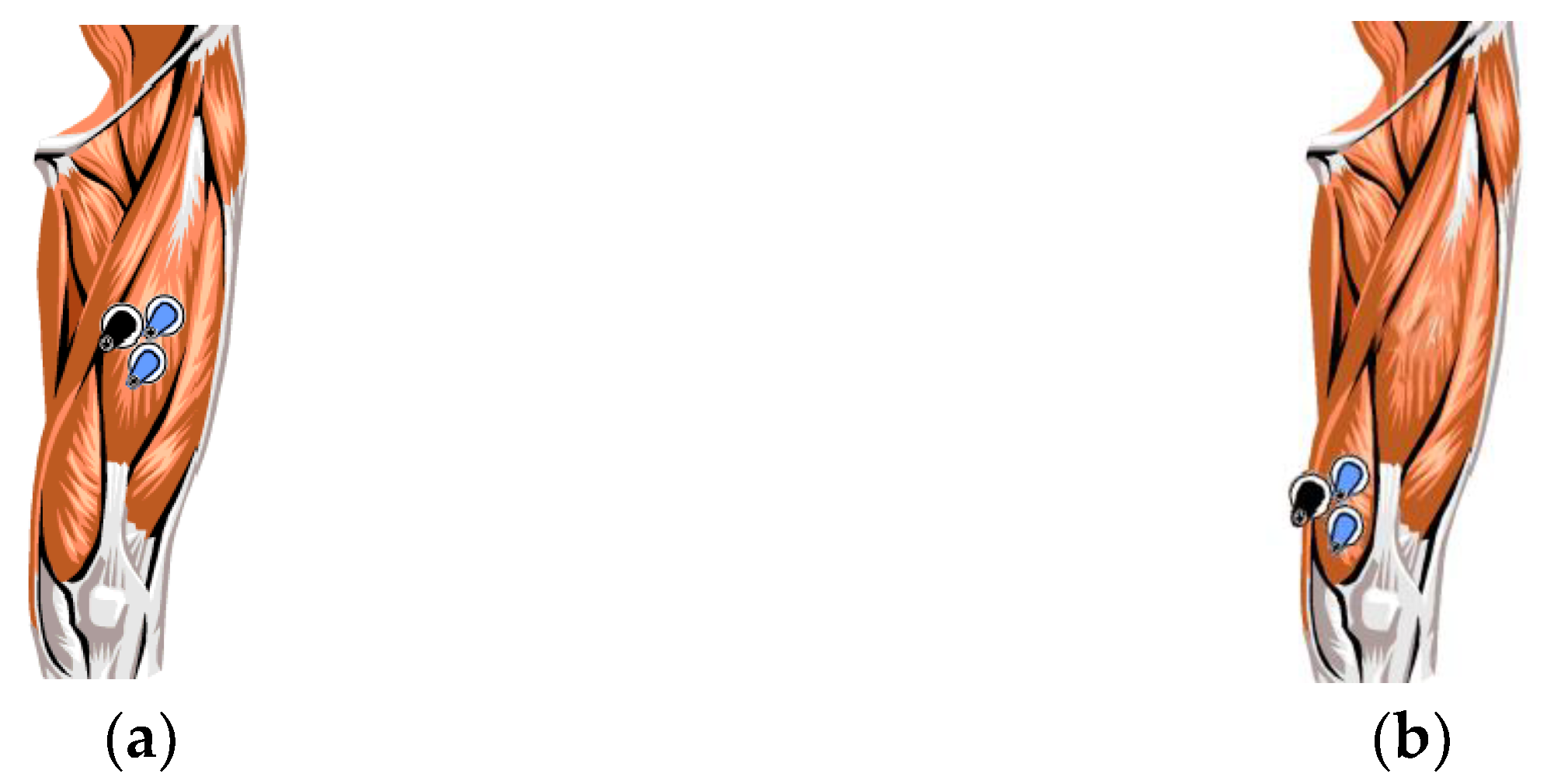
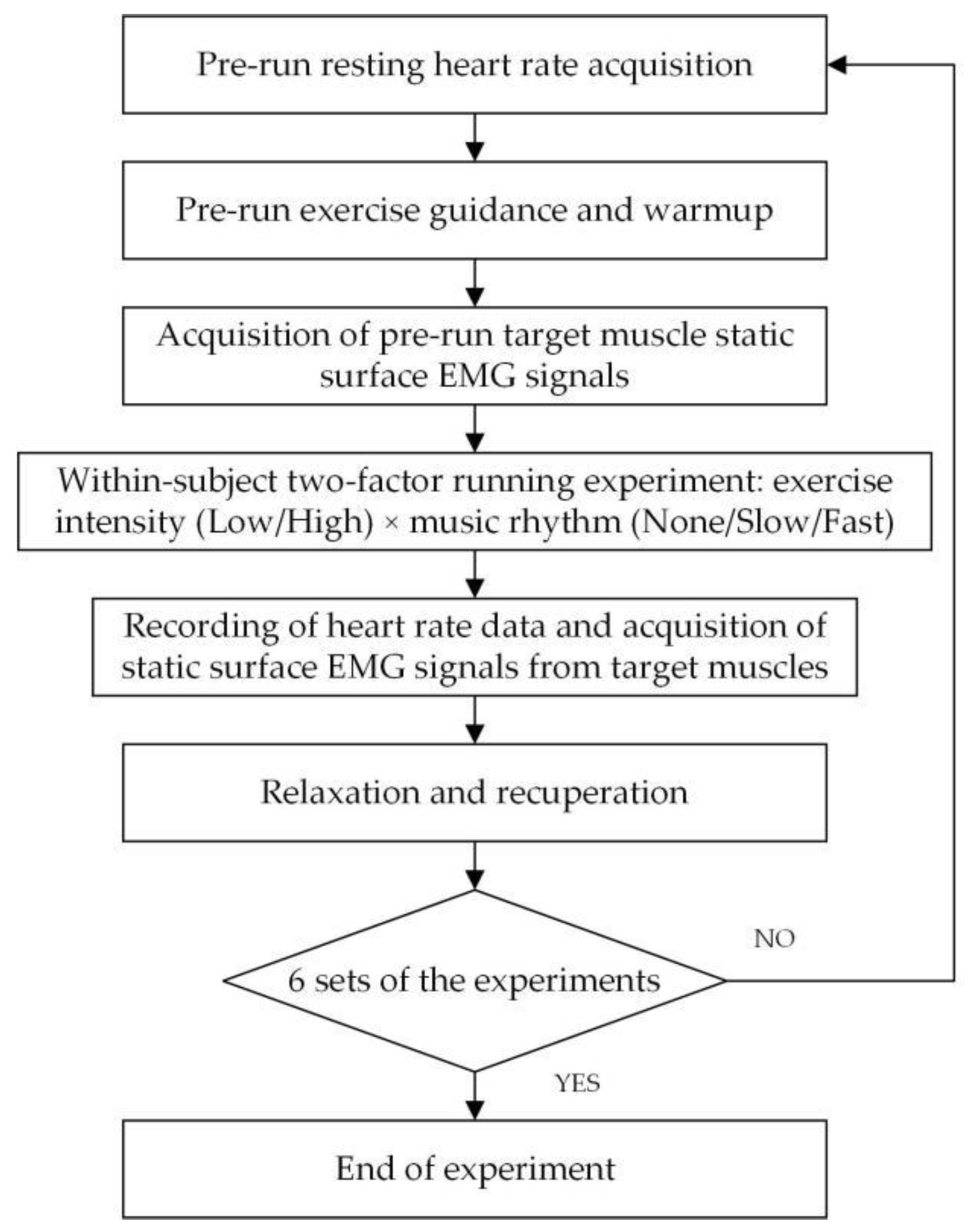
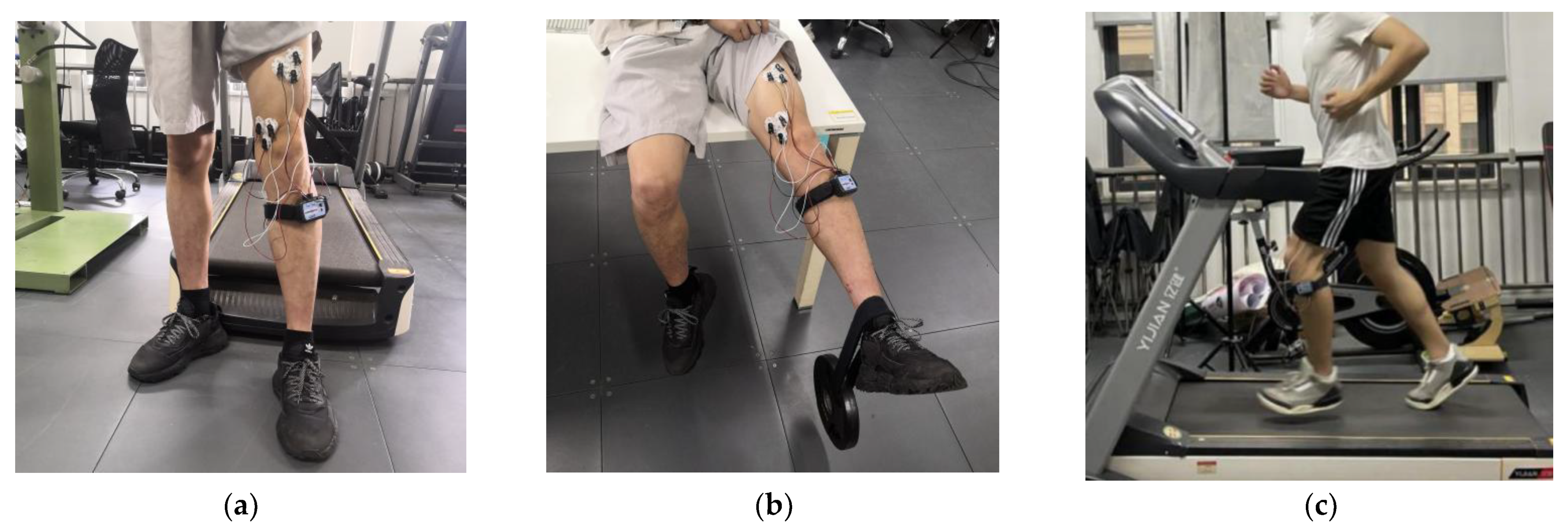
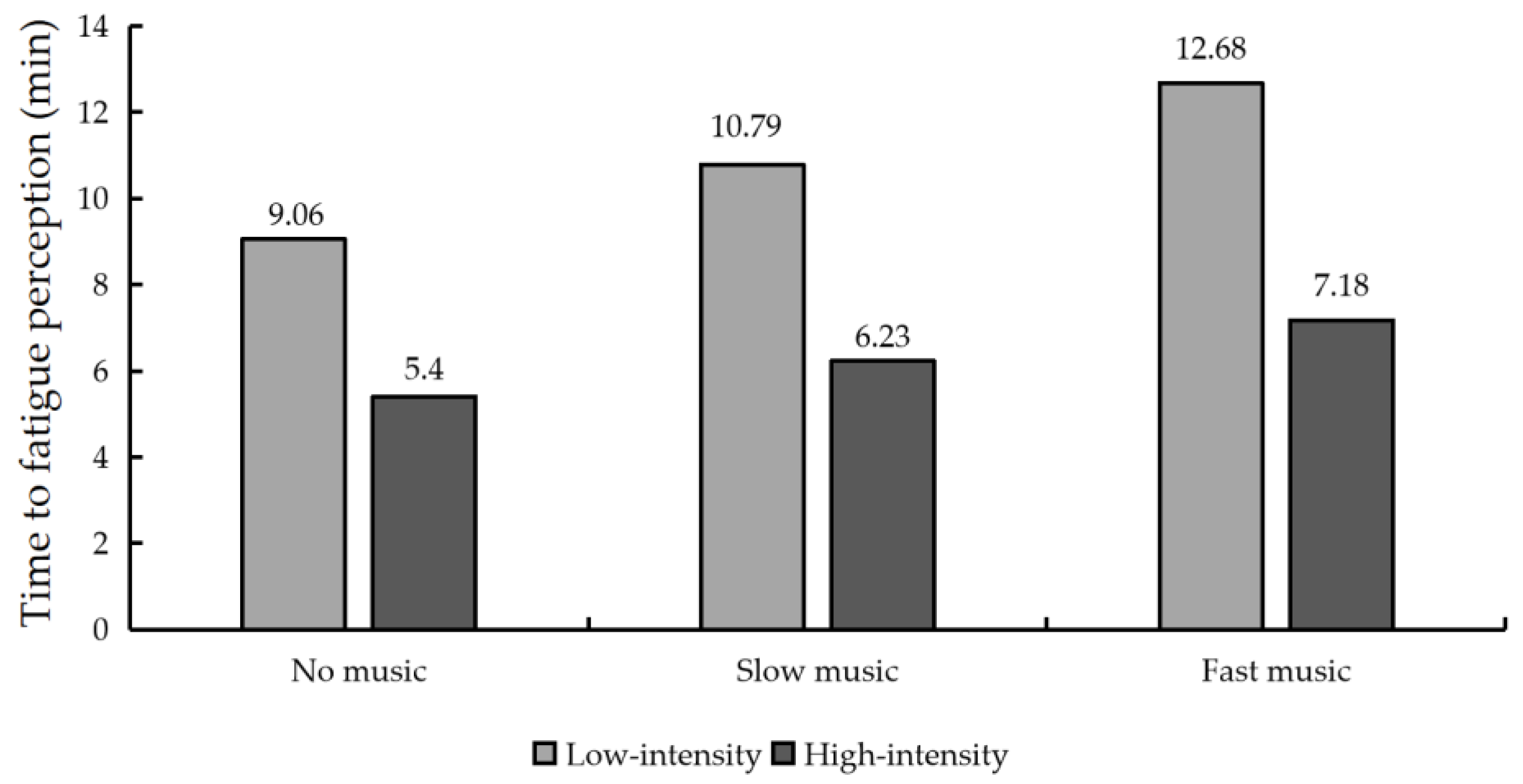
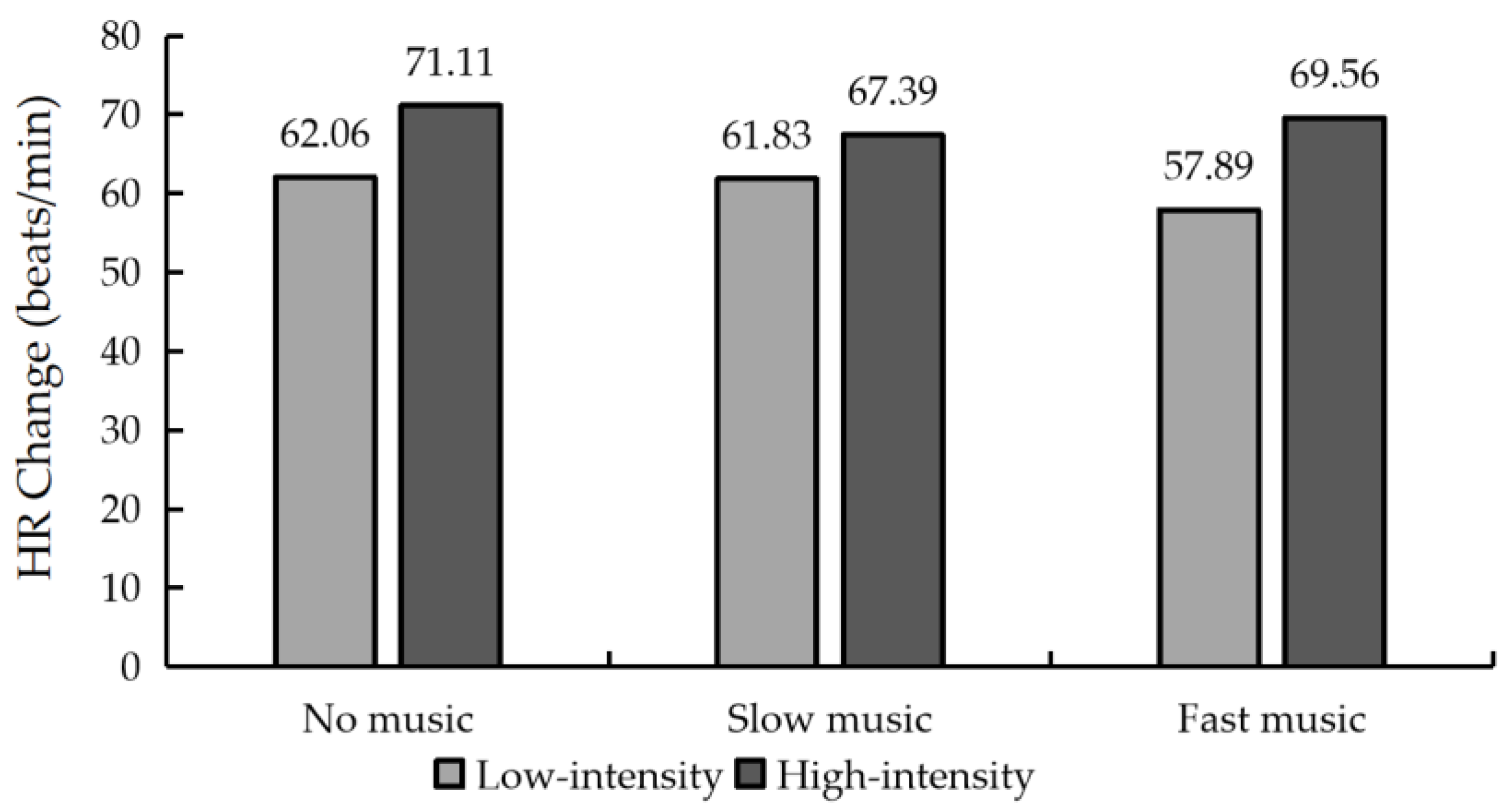

| Number of Subjects | Age (Years) | Height (cm) | Weight (kg) | Resting Heart Rate (Beats/min) |
|---|---|---|---|---|
| 18 | 23.95 ± 1.49 | 173.78 ± 1.54 | 64.39 ± 4.55 | 78.97 ± 8.15 |
| Music Tempo | Tracks | Duration/min | Beat/bpm |
|---|---|---|---|
| Slow music | Falcom Sound Team Jdk | 4′23″ | 90 |
| Grass Harvest | 3′14″ | 96 | |
| The des Alizes | 3′40″ | 100 | |
| Harunouta | 3′03″ | 90 | |
| Sakurairo Contrail | 2′28″ | 90 | |
| Springtime Affair | 2′49″ | 95 | |
| Regrettably, You Know | 2′04″ | 96 | |
| A Tiny Sunshine | 1′57″ | 99 | |
| Sakura Residential Area | 2′05″ | 97 | |
| Fast music | Cigarette Daydreams | 3′12″ | 150 |
| Hero | 3′34″ | 150 | |
| Shanghai Alice Magic Orchestra | 3′36″ | 152 | |
| Toy War | 1′55″ | 160 | |
| Where to Jun | 3′57″ | 160 | |
| Dream Land Days | 3′17″ | 155 |
| Score | Subjective Exercise Intensity | Subjective Exercise Fatigue | Score | Subjective Exercise Intensity | Subjective Exercise Fatigue |
|---|---|---|---|---|---|
| 6 | No exertion at all | Not hard at all | 14 | - | |
| 7 | Extremely light | Extremely relaxed | 15 | Hard (heavy) | Tired |
| 8 | - 1 | 16 | - | ||
| 9 | Very light | Very relaxed | 17 | Very hard | Very tired |
| 10 | - | 18 | - | ||
| 11 | Light | Relaxed | 19 | Extremely hard | Extremely tired |
| 12 | - | 20 | Maximal exertion | Trying one’s best | |
| 13 | Somewhat hard | A little tired |
| Parameter | High | Low | Music Tempo | Exercise Intensity | Music Tempo × Exercise Intensity | |||||||
|---|---|---|---|---|---|---|---|---|---|---|---|---|
| Fast | Slow | None | Fast | Slow | None | p-Value | η2 | p-Value | η2 | p-Value | η2 | |
| TFP (min) | 7.18 ± 2.36 | 6.23 ± 2.44 | 5.40 ± 1.94 | 12.68 ± 6.46 | 10.79 ± 4.86 | 9.06 ± 4.36 | 0.000 | 0.632 | 0.000 | 0.540 | 0.031 | 0.207 |
| HR difference 1 | 69.56 ± 10.66 | 67.39 ± 11.14 | 71.11 ± 10.18 | 57.89 ± 10.30 | 61.83 ± 10.81 | 62.06 ± 8.95 | 0.077 | 0.140 | 0.000 | 0.796 | 0.075 | 0.141 |
| MFRF difference 2 | −0.64 ± 4.98 | −2.02 ± 2.95 | 0.53 ± 4.45 | −0.86 ± 6.34 | −0.42 ± 6.81 | −0.96 ± 5.11 | 0.672 | 0.023 | 0.967 | 0.000 | 0.210 | 0.088 |
| MFVM difference 2 | −0.75 ± 5.91 | −0.89 ± 3.81 | 1.01 ± 4.2 | 0.38 ± 3.81 | −1.08 ± 5.6 | −0.79 ± 4.41 | 0.609 | 0.029 | 0.670 | 0.011 | 0.323 | 0.064 |
| Exercise Intensity | Pairwise Comparisons | ||
|---|---|---|---|
| No Music vs. | Slow Music vs. | Fast Music vs. | |
| Low intensity | Slow music: p = 0.004 | No music: p = 0.004 | No music: p = 0.000 |
| Fast music: p = 0.000 | Fast music: p = 0.000 | Slow music: p = 0.000 | |
| High intensity | Slow music: p = 0.000 | No music: p = 0.000 | No music: p = 0.0000 |
| Fast music: p = 0.000 | Fast music: p = 0.000 | Slow music: p = 0.000 | |
Publisher’s Note: MDPI stays neutral with regard to jurisdictional claims in published maps and institutional affiliations. |
© 2022 by the authors. Licensee MDPI, Basel, Switzerland. This article is an open access article distributed under the terms and conditions of the Creative Commons Attribution (CC BY) license (https://creativecommons.org/licenses/by/4.0/).
Share and Cite
Wu, J.; Zhang, L.; Yang, H.; Lu, C.; Jiang, L.; Chen, Y. The Effect of Music Tempo on Fatigue Perception at Different Exercise Intensities. Int. J. Environ. Res. Public Health 2022, 19, 3869. https://doi.org/10.3390/ijerph19073869
Wu J, Zhang L, Yang H, Lu C, Jiang L, Chen Y. The Effect of Music Tempo on Fatigue Perception at Different Exercise Intensities. International Journal of Environmental Research and Public Health. 2022; 19(7):3869. https://doi.org/10.3390/ijerph19073869
Chicago/Turabian StyleWu, Jianfeng, Lingyan Zhang, Hongchun Yang, Chunfu Lu, Lu Jiang, and Yuyun Chen. 2022. "The Effect of Music Tempo on Fatigue Perception at Different Exercise Intensities" International Journal of Environmental Research and Public Health 19, no. 7: 3869. https://doi.org/10.3390/ijerph19073869
APA StyleWu, J., Zhang, L., Yang, H., Lu, C., Jiang, L., & Chen, Y. (2022). The Effect of Music Tempo on Fatigue Perception at Different Exercise Intensities. International Journal of Environmental Research and Public Health, 19(7), 3869. https://doi.org/10.3390/ijerph19073869






